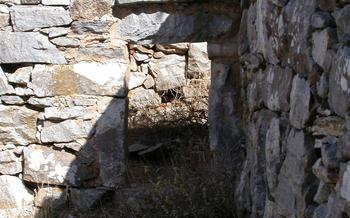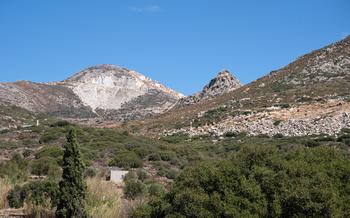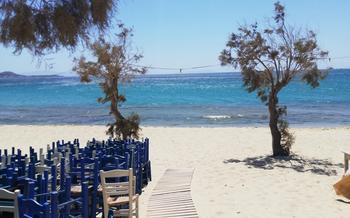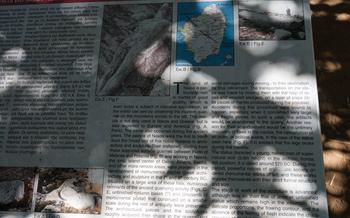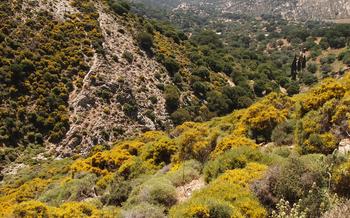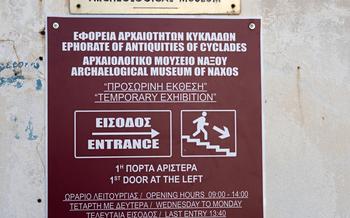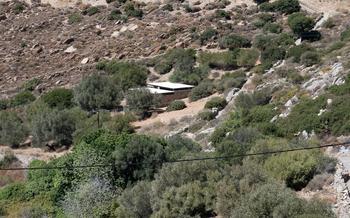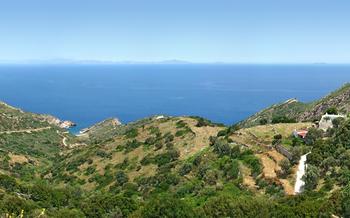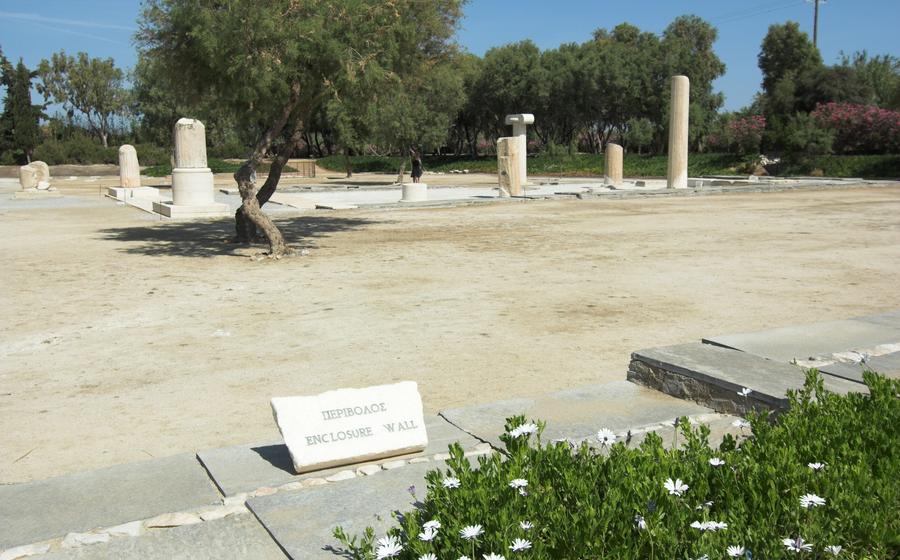
Temple of Dionysus
- Historical Significance
- Architectural Features
- Excavations and Discoveries
- Religious Rituals and Festivals
- Surrounding Area and Natural Beauty
- Transportation and Accessibility
- Photography and Videography
- Local Cuisine and Dining Options
- Accommodation Options
- Local Festivals and Events
- Guided Tours and Itineraries
- Sustainable Tourism and Conservation
- Insider Tip:
Historical Significance
The Temple of Dionysus in Naxos stands as a testament to the island's rich history and cultural heritage. Built in the 6th century BC, the temple is dedicated to the Greek god Dionysus, the patron of wine, revelry, and fertility. It played a significant role in Naxos's religious and cultural life, serving as a center for religious rituals, festivals, and celebrations. The temple's enduring presence and remarkably preserved state make it one of the most significant ancient monuments in Greece, offering visitors a glimpse into the religious practices and beliefs of the ancient Greeks.
Architectural Features
The Temple of Dionysus in Naxos stands as a testament to the architectural prowess of ancient Greece. Constructed in the 6th century BC, the temple exhibits a unique blend of Doric and Ionic elements, showcasing the transition between these two prominent architectural styles. The temple's imposing Doric columns, adorned with intricate fluting, support a majestic triangular pediment, its tympanum once filled with vibrant sculptures depicting scenes from Greek mythology. The harmonious proportions and elegant lines of the temple create a sense of awe and wonder, inviting visitors to marvel at the architectural mastery of the ancient Greeks.
The temple's construction materials, primarily local Naxian marble, contribute to its enduring beauty and resilience. The gleaming white marble, quarried from the nearby Mount Zas, exudes an ethereal glow, particularly under the warm Mediterranean sun. The careful selection of materials and the precise construction techniques employed have ensured the temple's remarkable preservation over the centuries.
One of the most striking architectural features of the Temple of Dionysus is its well-preserved frieze, which originally encircled the entire temple. The frieze depicts a continuous narrative of mythical scenes, showcasing the adventures and exploits of Dionysus, the god of wine and revelry. These intricate carvings provide a glimpse into the rich mythology surrounding Dionysus and offer a valuable insight into the religious beliefs and practices of ancient Naxos.
Excavations and Discoveries
The Temple of Dionysus has undergone extensive excavation and archaeological research over the years, revealing significant artifacts and remains that shed light on its history and religious significance. In the 19th century, initial excavations uncovered the temple's foundations, columns, and architectural fragments. Further excavations in the 20th century uncovered additional structures and artifacts, including pottery, sculptures, and inscriptions.
Among the notable discoveries are fragments of a large marble statue of Dionysus, which once stood inside the temple. The statue depicts the god in a majestic pose, holding a wine cup and a thyrsus, a symbol of his power. Other significant finds include inscriptions that provide valuable information about the temple's construction, religious rituals, and the cult of Dionysus.
Ongoing research and conservation efforts continue at the Temple of Dionysus, aimed at preserving and protecting its remains for future generations. Archaeological teams work to restore and stabilize the temple's structures, document and study the artifacts, and gain a deeper understanding of the site's history and significance. Recent discoveries include a well-preserved section of the temple's roof, offering new insights into its original appearance and construction techniques.
Religious Rituals and Festivals
The Temple of Dionysus was a central location for religious rituals and festivals honoring the Greek god Dionysus. These celebrations were an integral part of Naxos's religious and cultural life. The temple served as a venue for various ceremonies and festivities dedicated to Dionysus, the patron of wine, revelry, and theatrical arts.
During these festivals, the temple became a hub of religious activities. Devotees would gather to offer sacrifices, prayers, and libations to Dionysus. Ritualistic processions, accompanied by music, dance, and performances, were held in honor of the god. The temple's surroundings would come alive with the joyous celebrations, creating a vibrant atmosphere of devotion and merriment.
The most prominent festival associated with the temple was the Great Dionysia. This annual event was a grand celebration that included theatrical performances, competitions, and processions. The temple served as the focal point for these festivities, where plays and musical performances were presented in honor of Dionysus. The Great Dionysia was a significant cultural event that attracted visitors from across the region, showcasing the island's rich artistic traditions.
The temple's religious significance extended beyond the Great Dionysia. It was also a site for other festivals and rituals throughout the year. These celebrations honored various aspects of Dionysus's mythology and his role in the lives of the Naxians. The temple provided a sacred space for the community to come together, celebrate their faith, and seek the god's blessings.
Surrounding Area and Natural Beauty
The Temple of Dionysus is nestled amidst the picturesque landscapes of Naxos, offering visitors a breathtaking fusion of history and nature. Its location on a hilltop overlooking the crystal-clear waters of the Aegean Sea creates a mesmerizing backdrop for exploring this ancient site. The temple grounds themselves are surrounded by lush greenery, with olive groves, vineyards, and fragrant wildflowers painting a vibrant tapestry. Visitors can take advantage of the scenic surroundings by indulging in leisurely walks or hikes through the nearby trails, discovering hidden corners and capturing panoramic views of the temple and the surrounding countryside. The area is also home to a variety of unique flora and fauna, making it a delight for nature enthusiasts and birdwatchers alike. Whether you're seeking tranquility amidst nature or simply admiring the temple's harmonious blend with its surroundings, the natural beauty of the area is sure to leave a lasting impression.
Transportation and Accessibility
Reaching the Temple of Dionysus is a breeze from Naxos Town, the island's main port and transportation hub. Public buses offer a convenient and affordable option, departing regularly from the town center and dropping you off near the temple entrance.
If you prefer a more independent mode of transportation, rental cars and scooters are widely available on Naxos. Driving to the temple offers the freedom to explore the island at your own pace and discover hidden gems along the way. Just be sure to adhere to local traffic regulations and exercise caution on the winding roads.
For those seeking a guided experience, organized tours that include a visit to the Temple of Dionysus are readily available. These tours often combine visits to other historical sites and attractions on the island, providing a comprehensive overview of Naxos's rich history and culture.
The temple site is generally accessible for visitors with disabilities, featuring paved paths and ramps. However, it's advisable to check with local authorities or tour operators in advance to ensure any specific needs are accommodated. Parking options are available in the vicinity of the temple, though it's worth noting that during peak tourist season, finding a spot can be challenging.
Photography and Videography
Whether you're a professional photographer or simply an enthusiast with a smartphone, the Temple of Dionysus is a visual feast waiting to be captured. With its ancient architecture, dramatic natural surroundings, and picturesque views of the Aegean Sea, the temple offers endless opportunities for stunning photographs. For the best results, aim to visit during the golden hours of sunrise or sunset when the soft light casts a warm glow on the temple's columns and sculptures. Experiment with different angles to emphasize the temple's majesty, such as shooting from below to capture its imposing height or from a distance to showcase its harmonious proportions against the backdrop of the sea and sky. While photography is generally permitted at the temple, it's essential to respect the sanctity of the site and avoid using tripods or flash photography that may disturb other visitors or damage the ancient ruins.
Local Cuisine and Dining Options
The Temple of Dionysus stands as a testament to the rich history and culture of Naxos, and its surroundings are equally steeped in culinary delights. The island offers a diverse range of dining options for visitors to savor the essence of Greek cuisine.
In the vicinity of the temple, travelers can find charming tavernas and restaurants that showcase the authentic flavors of Naxos. The menu often features fresh seafood, succulent grilled meats, and mouthwatering local specialties. Indulge in the aromatic "patatato," a Naxian twist on moussaka made with potatoes, or relish the "sfougato," a savory cheese pie that reflects the island's unique culinary heritage.
For a truly memorable dining experience, venture into Naxos Town, where a vibrant culinary scene awaits. Explore the narrow cobbled streets and discover hidden gems that offer traditional dishes with a contemporary twist. Sample the delectable "kitron," a local liqueur crafted from the fragrant citron fruit, or tantalize your taste buds with the "melitinia," a sweet delicacy made from honey and sesame seeds.
Whether savoring the culinary delights at a charming taverna overlooking the Aegean Sea or immersing yourself in the bustling atmosphere of Naxos Town's restaurants, the island's cuisine promises an unforgettable gastronomic journey that complements the historical and cultural experience of visiting the Temple of Dionysus.
Accommodation Options
When seeking accommodation near the Temple of Dionysus, Naxos offers a diverse range of options to suit every traveler's preference and budget. Numerous hotels, guesthouses, and vacation rentals are scattered throughout the island, providing a comfortable and convenient base for exploring the temple and its surroundings.
For those seeking a luxurious and immersive experience, the five-star Naxos Resort offers beachfront elegance with stunning views of the Aegean Sea. Alternatively, the family-run Hotel Galini provides a more intimate atmosphere with its charming rooms and warm hospitality.
For budget-conscious travelers, the Naxos Youth Hostel offers affordable dorm-style accommodations and a social environment. Meanwhile, the traditional Cycladic-style studios and apartments of Pension Irini provide a cozy and authentic Greek experience.
If you prefer the freedom and privacy of a vacation rental, many options are available, ranging from cozy cottages to spacious villas. These rentals often offer self-catering facilities, allowing visitors to prepare their own meals and enjoy the local cuisine.
No matter your choice of accommodation, you'll find yourself within easy reach of the Temple of Dionysus and the many other attractions that Naxos has to offer.
Local Festivals and Events
The Temple of Dionysus and the island of Naxos are alive with local festivals and events that celebrate the island's rich cultural heritage and traditions. One of the most significant events is the annual Naxos Wine Festival, held in August. This vibrant festival showcases the island's renowned wines, with tastings, workshops, and live music filling the streets of Naxos Town. Visitors can indulge in local delicacies, enjoy traditional music and dance performances, and immerse themselves in the festive atmosphere.
Another highlight is the Feast of Saint George, celebrated on April 23rd. This religious festival honors the patron saint of Naxos and features processions, church services, and lively celebrations throughout the island. Visitors can witness traditional rituals, participate in cultural events, and savor delicious local dishes prepared for the occasion.
For those interested in experiencing the island's folklore, the Naxos Folklore Festival is a must-attend event. Held in July, this festival brings together local musicians, dancers, and artisans to showcase Naxos's rich cultural traditions. Visitors can watch traditional dance performances, listen to live music, and admire handmade crafts and artwork.
These events offer a unique opportunity to immerse oneself in the local culture, interact with friendly islanders, and create lasting memories. By participating in these festivals, visitors can gain a deeper appreciation for the history, traditions, and vibrant spirit of Naxos.
Guided Tours and Itineraries
Exploring the Temple of Dionysus with a knowledgeable guide can greatly enhance your understanding and appreciation of its history, architecture, and significance. Guided tours are available in various languages and offer insights into the temple's religious rituals, mythology, and connection to the island's culture.
When choosing a guided tour, consider your interests and preferences. Some tours focus on the temple's history and architecture, while others delve deeper into its religious significance and myths. You can book guided tours online or through local tour operators in Naxos Town.
To make the most of your visit, consider creating a customized itinerary that allows you to explore the temple at your own pace. Start by visiting the temple early in the morning or late afternoon to avoid the crowds and enjoy the best lighting conditions for photography. After exploring the temple, take some time to wander through the nearby ruins of ancient Naxos, including the Temple of Apollo and the Venetian Castle.
For a more immersive experience, plan your visit to coincide with one of Naxos's many festivals or events, such as the Naxos Wine Festival or the Dionysus Festival. These events offer a chance to witness traditional performances, taste local delicacies, and immerse yourself in the island's vibrant culture.
Sustainable Tourism and Conservation
As a responsible traveler, it's essential to prioritize sustainable practices when visiting the Temple of Dionysus. Respect the historical and cultural significance of the site by avoiding touching or climbing on ancient structures. Minimize your environmental impact by reducing single-use plastics and opting for eco-friendly transportation options. Support local conservation efforts by patronizing businesses that actively contribute to preserving the temple and its surroundings. Remember, your actions as a visitor can help ensure that future generations can continue to appreciate and learn from this remarkable ancient site.
Insider Tip:
For a truly immersive experience, visit the Temple of Dionysus during the annual Naxos Wine Festival, held in August. This vibrant celebration honors the god of wine and features wine tastings, traditional music and dance performances, and lively street processions. Participate in the festivities, sample the local wines, and soak up the infectious energy of this unique cultural event.

